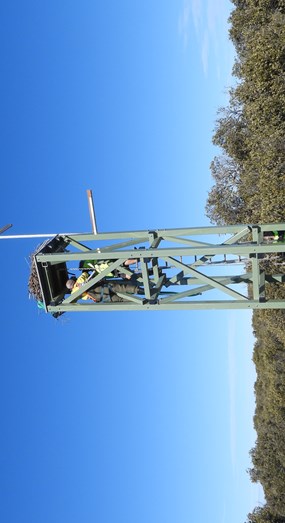

Artificial nesting platforms were constructed as part of a critical conservation project for the endangered Eastern Osprey (fish-eating eagle). They are increasingly threatened in South Australia, with an estimated 50 pairs remaining. They have experienced a 26% decline over the past decade due to disturbance and predation at nesting sites.
A solution to this population decline is raised nesting platforms along the coast made from our Composite Fibre Technology sections and other materials, encouraging this species to raise their young out of harm’s way. The nests are moved from vulnerable locations and placed on these platforms. The birds almost immediately take up these new homes atop the platforms, where their eggs and offspring are afforded greater protections.
This technique has been used internationally with great success, so we are hoping to see similar results in South Australia. As a result of the artificial nesting platforms, Osprey occupied territories on Yorke Peninsula have now increased from one in 2017 to five in September 2022.
Our composite fibre structures are innovative fibreglass sections made using a unique pull-winding process. They can be used as a replacement for steel, aluminium, and timber and have the added advantage of being resistant to corrosion, lightweight yet strong, and easy to install and maintain. This is especially important in this case because the nesting platforms are often exposed to harsh coastal conditions and, in some cases, submerged in sea water.
This project could not have been completed without the Southern Yorke Peninsular Landcare Group, who obtained funding for the project, and the Ardrossan Men’s Shed, who fabricated the CFT structures in their workshop. A small team of local community volunteers installed the nesting platforms in remote coastal locations. Other organisations involved include BirdLife Australia, Birds South Australia, the Northern and Yorke Landscape Board, the Department for Environment and Water, and other local community groups.
Passionate Birds SA Volunteer, Ian Falkenberg, said, "These nesting platforms play a critical role in the survival of the osprey, which has significantly declined due to loss of breeding habitat and predation from feral pests such as foxes and other scavengers. It is important to install platforms in preferred osprey nesting habitats; however, these sites are often remote and sometimes inaccessible for plant and equipment. So Composite Fibre Technologies were used as they met the site requirements for installation and were carried to the site via helicopter and could be installed by community volunteers."
Regional Manager, Wagners Composite Fibre Technologies, Ryan Leeson said, "This project was an opportunity for us to participate in a venture to safeguard an endangered species and demonstrate that our Composite Fibre Technology products are lightweight and easy to install. They are also well suited to the nesting locations as they will never corrode and require virtually zero maintenance, even in a highly saline marine environment."